

The end of the year is always busy: Prepping for the holidays, making time for family, and planning for the new year take both time and commitment. As a small business owner, you have an even longer list of things to think about at the end of the year, such as income statements , taxes, and employee incentives.
It can be tricky to balance work and life as December 31 approaches. Nevertheless, devoting some attention to your business not only helps you end the current year on a high note, but also sets you up for success in the new year.
What actually needs to be done at year-end, and what’s more of a nice-to-have? Use this year-end checklist to ensure you take care of necessary business tasks before the end of the year. With these off your plate, you can focus on the things that matter most.

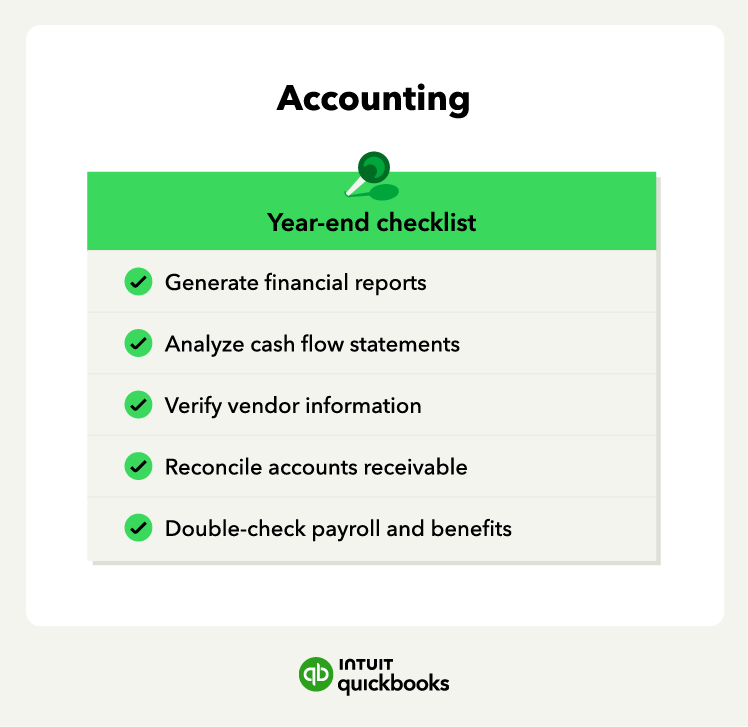
The end of the year is a great time to assess where your business stands financially and how its current financial situation compares to previous years. Use your preferred accounting software or system to generate a financial report . This report typically includes an income statement, a balance sheet , and a cash flow statement.
Your income statement, also known as a profit and loss statement , is crucial to understanding your profits. This financial report is the best way to see, at a glance, where your business stands financially and what your outlook is like for the new year. If your profits are lower than expected, you may want to make some changes as you head into the new year. If your profits are higher than expected, it might be a good time to make some larger investments for which you can record future depreciation.
It’s a good idea to speak with an accountant before making big purchases. An accountant will make sure you have the cash on hand to make the purchase and help you understand depreciation rules.

No matter what stage your business is in, QuickBooks can help you manage your business finances.
Start hereA cash flow statement records how your business spent money throughout the year. Cash inflows equate to income, and cash outflows are business expenses. Your goal is to generate more money than you’re spending. Toward the end of the year, it’s a good idea to analyze your cash flow statement to identify cash flow trends throughout the year.
Cash flow problems happen for a variety of reasons. The faster you can identify the problem, the faster you can correct it. It’s important to note that net cash outflows don’t necessarily indicate a business has a cash flow problem. Cash flow becomes a problem when outflows exceed inflows.
To calculate cash flow, separate cash flows into three specific activities:
The cash flow formula adds a beginning cash balance with net changes in each activity to determine the ending cash balance.
A lot can change for a business in a year, and the same goes for your vendors.
At the end of the year, verify that the contact information, including phone number, email address, and contact name, is still correct for each of your vendors. Purge the system of any inactive vendors or inaccurate information. If time permits, evaluate your vendor relationships and look for opportunities to negotiate better deals in the new year.
Accounts receivable is the amount your customers owe you after purchasing your goods or services on credit. It’s a running list of unpaid invoices and clients that still owe money for work already completed. If your list is longer than you’d like, you’re not alone. US business owners averaged around $32,000 in unpaid invoices, according to QuickBooks 2023 Small Business Insights .
Calculating your accounts receivable turnover ratio can tell you how efficiently your business collects revenue. A higher ratio indicates that your customers pay their debts quickly. A lower ratio indicates that your collections procedures could use some work.
No matter what your ratio, if you have outstanding receivables, it’s a good idea to collect funds from unpaid invoices before the end of the year. Reconciling accounts receivable boosts your cash flow and allows you to start the new year without outstanding invoices.
It’s better to stay on top of any issues or corrections you need to make payroll before the year ends. Ensure you account for taxable fringe benefits, such as third-party sick pay or a company car. Other benefits that are easy to forget include educational reimbursement, health and life insurance, and transportation subsidies.
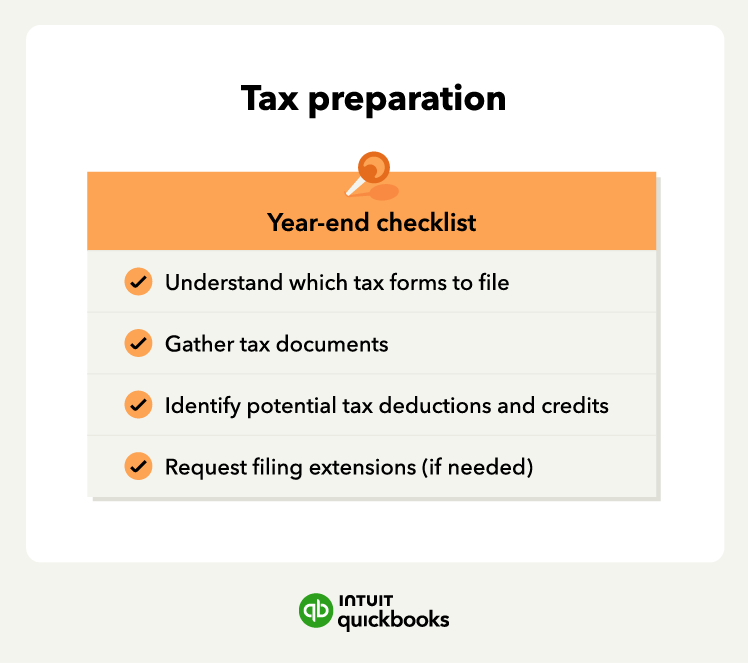
Preparing your taxes ahead of time ensures you have everything needed to file and can help avoid penalties. Knowing which forms you’ll need to file for small business taxes ahead of time is an essential step.
The tax form you have to file will depend on your business structure—and you might even have to file a couple of different forms. Some common tax forms for small businesses and solopreneurs include:
Before the year ends, consider talking to a dedicated tax professional to understand which forms you need to file and make a list of them.
You may have to look for different types of paperwork as tax season approaches. Stay prepared by keeping a tax checklist and gathering the necessary documents ahead of time.
Here are some common documents you may need to gather to submit your business’s taxes:
Plan ahead of time to find these documents, gather employee tax forms, and keep all documentation stored in one place to make it easier to file your taxes.
If you want to reduce your small business tax bills, look for tax deductions and credit opportunities before the year ends. You may find expenses and investments you can deduct from taxable income, which reduces how much you’ll owe for tax returns.
Understand which tax deductions and credits you’re eligible for before tax season to ensure a lower small business tax bill. Some common deductions for small businesses include:
There are also different small business tax credits you may qualify for, including the Investment Credit, Work Opportunity Credit, and Small Employer Health Insurance Premium Credit. Prepare the documentation beforehand and consult with a tax preparation expert to maximize your savings.
Sometimes your tax situation is complex, or you can’t prepare everything ahead of time. If you believe you won’t be able to file your business tax return on time, consider requesting a tax extension .
Use Form 7004 to get a six-month extension for business taxes. You’ll still have to keep up with your estimated tax payments even with an extension, as it only allows you to submit your tax forms later.
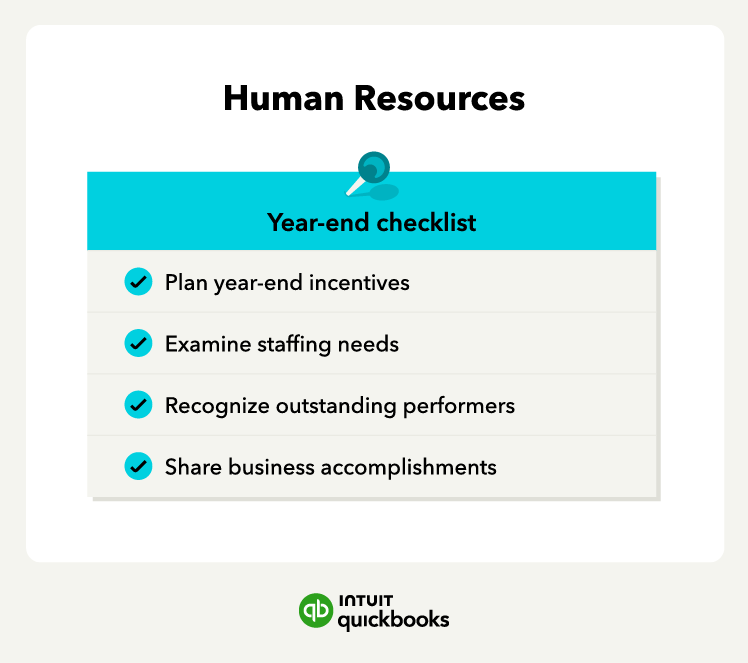
Once the financial tasks are out of the way, take a good, hard look at your team. After all, they’re the lifeblood of your business.
The end of the year is a great time to reward your team for the work they’ve done over the past 12 months. This reward could come in the form of business-wide paid time off, flexible schedules, and monetary incentives. A year-end reward or holiday bonus is a good way to boost morale and increase worker satisfaction as you head into the new year.
Take inventory of your team and workload to determine whether you’ll need to hire more employees in the new year—or hire your first one if you’re a solopreneur . You’ll want to be sure you’ve budgeted for any additional personnel you plan to hire within the first or second quarter.
On the flip side, your business needs may have changed throughout the year. If you’re overstaffed, consider creating new roles to reallocate your team’s talent. You might also consider reducing hours or rearranging schedules to better suit your business needs.
In addition, the end of the year is a good time to review your compensation and benefits plans to ensure they’re still competitive.
As the end of the year approaches, don’t forget to take a look back at everything you and your team have accomplished. Document your wins and share them widely. Your employees will appreciate ending the year on a high note, and they’ll feel motivated to hit the ground running come January. This is also a great time to recognize any outstanding performers and create promotional paths for them to follow.
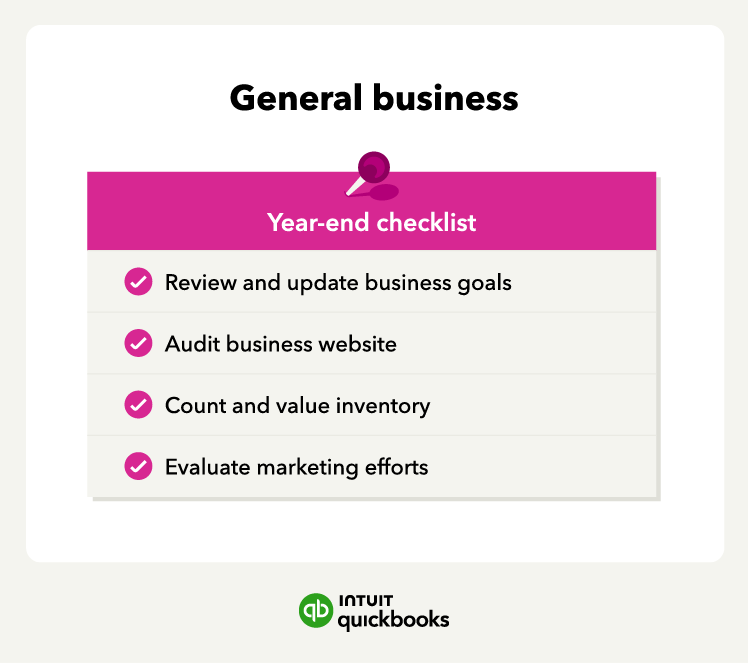
Using your financial statements, customer feedback, and input from your team, assess your goals from the previous year and determine whether or not you accomplished them. Did you achieve what you set out to do? Or did you find yourself taking an unexpected path to a different kind of success?
With the earnings from the previous year in mind, set goals for the coming year. Financial goals should be a given, but make room to evaluate management goals and client goals, too. Once you’ve written down a few goals for the new year, create a high-level action plan for each goal to help you achieve it.

You're never too small, and it's never too soon to know you're on track for success.
Start hereIn a world driven by e-commerce, it’s more important than ever to have a solid website for your business . First impressions matter, and for many of your customers, your website is the doorway to your business.
To start, go through your website and click on every single link. Try sending yourself an email or message from the “contact us” form. Call the 800 number and make sure it works. These may seem like mundane tasks, but these systems break all the time. As your digital calling card and first impression of your business, your website is an important commodity to keep in fine working order.
Counting and valuing inventory before the end of the year is a great opportunity to keep up with customer demand and use it on tax returns. Whether you have an automated inventory tracking system or are due for an inventory analysis, take some time at the end of the year to analyze your inventory.
Choose an inventory valuation method and establish a specific day and time to conduct the inventory count. This is also a good time to organize your inventory space to ensure all items are easily accessible and properly labeled. Then, record quantities, calculate total inventory value, and update financial statements so your business is ready for the next year.
Evaluate your business’s marketing efforts at the end of the year to identify the effectiveness of your strategies. Understanding what worked and what didn’t can help you make better decisions for the upcoming year.
Here are some steps to evaluate your marketing efforts:
Next, start planning ahead. Develop a marketing plan for the new year based on your evaluation. Outline specific changes, new strategies, and optimizations to promotional campaigns and sales targets.
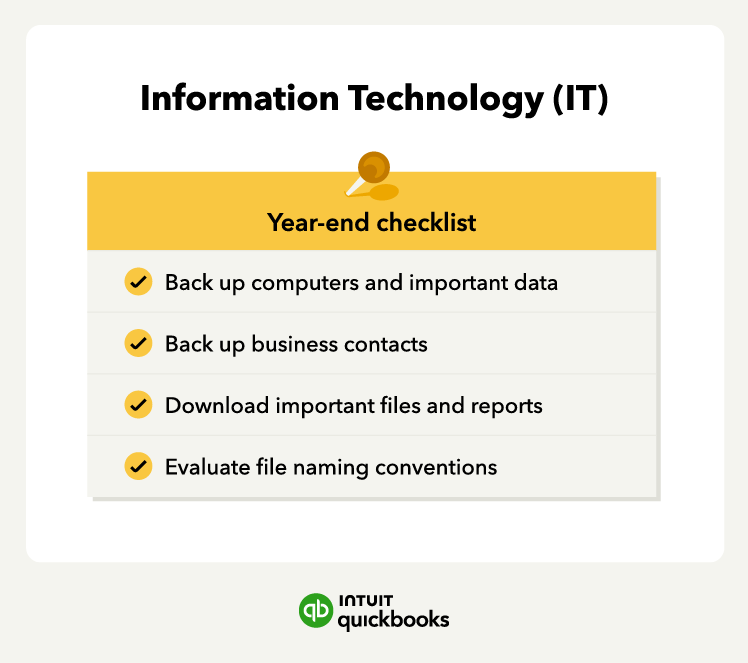
No matter how much or how little you work with technology, it’s still a good idea to make sure your IT ducks are in a row by the end of the year.
It’s best practice to keep backups of important data. Make sure to back up and secure your important files, including accounting documents, client information, creative briefs, and valuable emails. If your employees deal with important documents, provide them with external hard drives or access to a cloud-based storage system to ensure all data is stored safely and securely as you enter the new year.
Whether you do most of your business over the phone or via email, make sure to back up all of your contacts, even if that means writing them down in an old-fashioned Rolodex. In the same way that you updated your vendor information, make sure you have the most up-to-date information for your most important business contacts.
It might seem counterintuitive, but if you keep important documents or reports on a cloud-based storage system, it’s a good idea to download “hard” copies and back them up to an external hard drive. The golden rule for data backup is 2:1. That is, create two digital copies, stored in two separate locations, plus one offline copy (preferably stored somewhere else).
If you don’t already have a companywide file naming system, consider implementing one. For example, if you manually save receipts as PDF documents, you might adopt a convention like “LastName-Date-InvoiceNumber.”
Adopting file-naming conventions across the company is especially important for businesses that share servers that multiple employees access. When everyone follows the same naming conventions, your files stay organized and easily accessible. Even if you don’t share servers, it’s still a good idea to implement some naming conventions to keep your files organized as your business grows.
As you work to back up your documents and data, make sure you’ve named and organized your files appropriately. Change file names now so you’re not stuck searching for something come June.
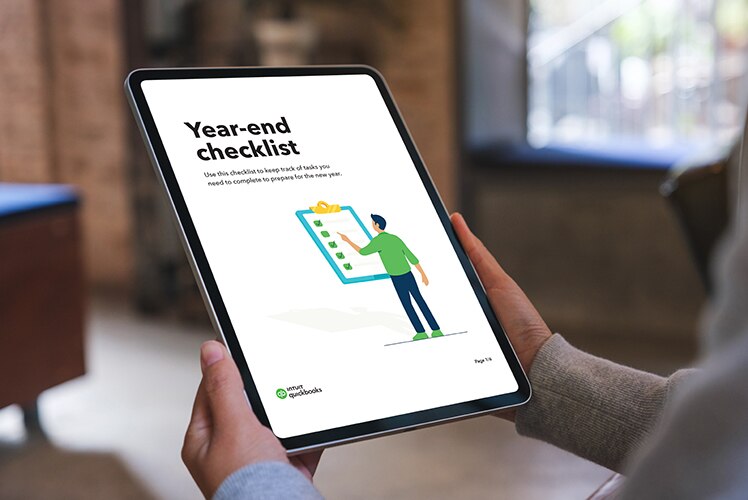

Closing out the end of the year is a daunting task, but it is manageable if you keep and follow this year-end checklist. If you work with a trusted accountant, make an appointment with them as early as possible. And as always, the more you can plan for these tasks throughout the year, the easier your year-end will be.
Investing in all-in-one accounting software, like QuickBooks , helps you keep track of everything, such as financial reports, payroll, and inventory, so you won’t have to worry about fetching documents and reports to prepare for the new year.
Recommended for you
Small business tax preparation checklist 2024: 6 steps business owners should know
January 10, 2024
Starting a business
Free business plan template and how to fill it out
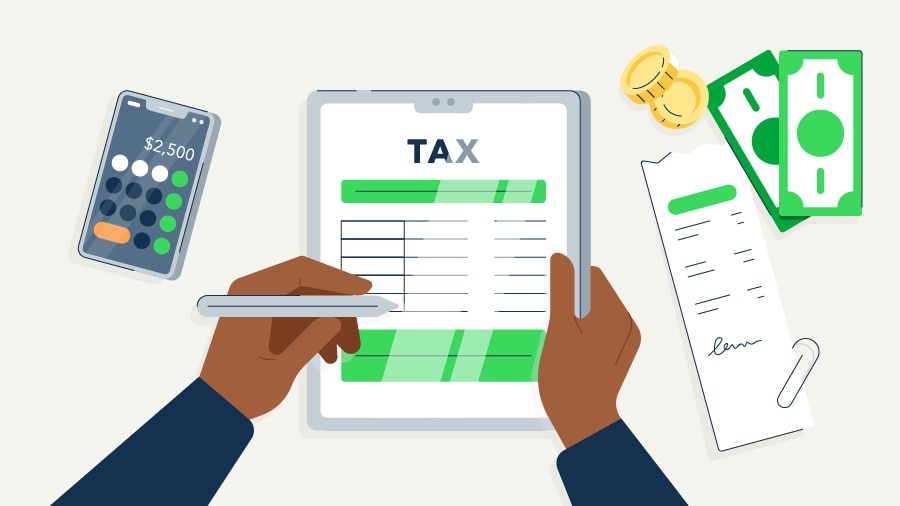
13 important documents to give your accountant for tax season
January 26, 2024
We provide third-party links as a convenience and for informational purposes only. Intuit does not endorse or approve these products and services, or the opinions of these corporations or organizations or individuals. Intuit accepts no responsibility for the accuracy, legality, or content on these sites.
**Product information
QuickBooks Live Assisted Bookkeeping: This is a monthly subscription service offering ongoing guidance on how to manage your books that you maintain full ownership and control. When you request a session with a Live Bookkeeper, they can provide guidance on topics including: bookkeeping automation, categorization, financial reports and dashboards, reconciliation, and workflow creation and management. They can also answer specific questions related to your books and your business. Some basic bookkeeping services may not be included and will be determined by your Live Bookkeeper. The Live Bookkeeper will provide help based on the information you provide.
QuickBooks Live Full-Service Bookkeeping: This is a combination service that includes QuickBooks Live Cleanup and QuickBooks Live Monthly Bookkeeping.
1. QuickBooks Online Advanced supports the upload of 1000 transaction lines for invoices at one time. 37% faster based off of internal tests comparing QuickBooks Online regular invoice workflow with QuickBooks Online Advanced multiple invoice workflow.
2. Access to Priority Circle and its benefits are available only to customers located in the 50 United States, including DC, who have an active, paid subscription to QuickBooks Desktop Enterprise or QuickBooks Online Advanced. Eligibility criteria may apply to certain products. When customers no longer have an active, paid subscription, they will not be eligible to receive benefits. Phone and messaging premium support is available 24/7. Support hours exclude occasional downtime due to system and server maintenance, company events, observed U.S. holidays and events beyond our control. Intuit reserves the right to change these hours without notice. Terms, conditions, pricing, service, support options, and support team members are subject to change without notice.
3. For hours of support and how to contact support, click here.
4. With our Tax Penalty Protection: If you receive a tax notice and send it to us within 15-days of the tax notice we will cover the payroll tax penalty, up to $25,000. Additional conditions and restrictions apply. See more information about the guarantee here: https://payroll.intuit.com/disclosure/.
Terms, conditions, pricing, special features, and service and support options subject to change without notice.
QuickBooks Payments: QuickBooks Payments account subject to eligibility criteria, credit, and application approval. Subscription to QuickBooks Online required. Money movement services are provided by Intuit Payments Inc., licensed as a Money Transmitter by the New York State Department of Financial Services. For more information about Intuit Payments' money transmission licenses, please visit https://www.intuit.com/legal/licenses/payment-licenses/.
QuickBooks Money: QuickBooks Money is a standalone Intuit offering that includes QuickBooks Payments and QuickBooks Checking. Intuit accounts are subject to eligibility criteria, credit, and application approval. Banking services provided by and the QuickBooks Visa® Debit Card is issued by Green Dot Bank, Member FDIC, pursuant to license from Visa U.S.A., Inc. Visa is a registered trademark of Visa International Service Association. QuickBooks Money Deposit Account Agreement applies. Banking services and debit card opening are subject to identity verification and approval by Green Dot Bank. Money movement services are provided by Intuit Payments Inc., licensed as a Money Transmitter by the New York State Department of Financial Services.
QuickBooks Commerce Integration: QuickBooks Online and QuickBooks Commerce sold separately. Integration available.
QuickBooks Live Bookkeeping Guided Setup: The QuickBooks Live Bookkeeping Guided Setup is a one-time virtual session with a QuickBooks expert. It’s available to new QuickBooks Online monthly subscribers who are within the first 30 days of their subscription. The QuickBooks Live Bookkeeping Guided Setup service includes: providing the customer with instructions on how to set up chart of accounts; customized invoices and setup reminders; connecting bank accounts and credit cards. The QuickBooks Live Bookkeeping Guided Setup is not available for QuickBooks trial and QuickBooks Self Employed offerings, and does not include desktop migration, Payroll setup or services. Your expert will only guide the process of setting up a QuickBooks Online account. Terms, conditions, pricing, special features, and service and support options subject to change without notice.